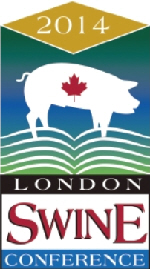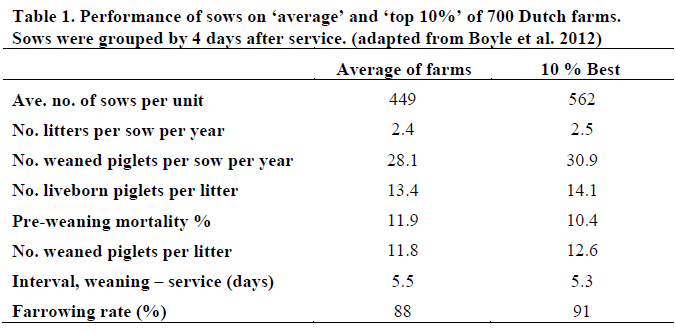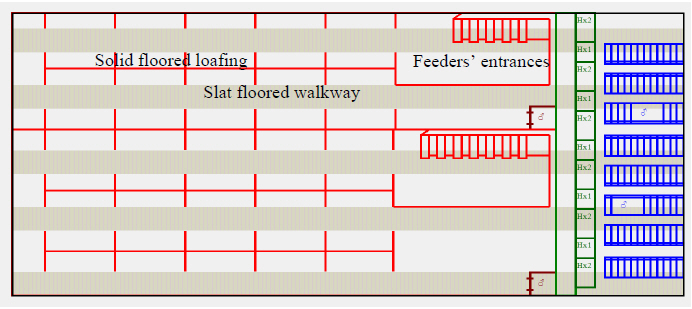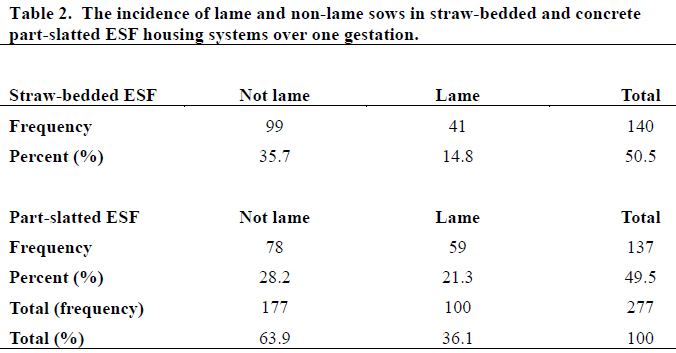



Group Sow Housing: the Facts
Housing pregnant sows in groups is not a new concept. Many North American pork producers do not favour to replace gestation stalls but this is the way of the future, according to Laurie Connor of the University of Manitoba at the London Swine Conference 2014. Dr Connor outlines the research into the quantity and quality of space required and stresses the importance of good stockmanship.
Abstract
Accumulated knowledge from research and experience in other countries as well as our own has provided tools to successfully house pregnant sows in groups, while providing individualized animal attention, an environment supportive of sow well-being and equal or better sow productivity.
However, there is no template for the ideal system. The “best” housing system for any producer is one that is designed and operated based on attention to a number of key principles or concepts: ability for individualized sow attention and feeding; appropriate quantity and quality of space accessible to each sow in the group; mixing strategies to minimize aggression, injuries and distress i.e. facilitate establishment and maintenance of stable social hierarchy in the group; and stockpeople that are knowledgeable, attentive and like working with sows.
Guidelines provide us with good recommendations for space allowance, pen design and layout, and group mixing strategies as well as sow behaviour indicators of well-being and distress.
However, more information and research focus is needed on clearer definition of space requirements to accommodate dynamic behaviours and to provide better understanding of genotype, temperament and group environment interactions. Lameness associated issues, a particular concern for grouped sows and their ability to access resources, are an important area of ongoing research along with investigations into improving flooring characteristics for ease of sow movement and comfort.
Introduction
Housing pregnant sows in groups is far from a new concept. But, it is one that many North American pork producers do not favour to replace gestation stalls. However, many producers do recognize that this is the way of the future; for some, that future is now.
Our goals in converting from full-pregnancy confinement in stalls to sow group housing are:
- to retain the benefits of stalls and of group systems while eliminating the negative housing features of both
- to provide an environment conducive to good animal welfare
- to retain or improve sow productivity/performance and
- be economically successful.
The focus of this paper will be identifying things that we have learned and do know about group housing with emphasis on features important for sow well-being and success, and will conclude with some factors for success that we still need to work on.
What Do We Know about Sow Group Housing?
Markets do and will demand group sow housing
The European Union (EU) ban on the pregnancy-long housing of sows in gestation stalls has been in full effect since January, 2013. Although countries in North America have resisted national legislation banning these stalls, they are banned in four states and committed to being phased-out in another five. Major pork integrators, Smithfield’s and Tyson Foods in the United States and Maple Leaf Foods in Canada, as well as several fast-food chains (e.g. Wendy’s, McDonald’s, Burger King, Tim Horton’s) have documented and publicly announced their requirement for “stall-free” pork, either immediately or within a defined time period. Producers not housing sows as required by the buyers within the stipulated time-frame will not likely be marketing pigs.
Sow reproductive performance can be the same or better than in stall systems
Understandably, an important criterion is that sow productivity cannot be compromised by converting to group housing. Certainly, both favourable and unfavourable comparisons can be found in the literature. However, a detailed review of the literature published 10 years ago (McGlone et al 2004a) already concluded that well-managed group sow systems did not compromise sow welfare or productivity. Currently, we are all aware that farmers in Denmark, using sow group housing, set the bar at 30 pigs per sow and year a few years ago. Similarly, good reproductive performance is considered standard in the Netherlands (Table 1) and is certainly achievable in Canada (Connor, 2012).
During a farm’s transition period from stalls to group housing, there may be an initial dip in production performance especially if current sow inventory is moved into a group environment. Sows that have not been in groups may have to learn social ‘etiquette’ and may show more aggression initially. They will also likely be less fit and therefore more prone to locomotion problems and injuries associated with physical activity and fighting on concrete and slatted floors.

No one system suits all
One of the daunting aspects of converting to group housing is that, unlike standard stall systems, there are many choices that can impact the functionality of the system, animal welfare and productivity of the herd. Most often the system is designed around the choice of feeding method and even then there are several options within the general categories of competitive and non-competitive feeding (e.g. see Levis and Connor, 2013; Connor et al, 2014).
Apart from the actual system there are some key features and concepts to consider:
- ability to attend to and feed individual sows in order to maintain health and appropriate body condition.
- group size and dynamics to accommodate ease of management and optimize stable sow group formation whether in static or dynamic groups.
- space allocation and pen shape or layout.
- timing of sow grouping/mixing – at weaning, just after breeding or post-implantation.
- methods of sow introduction or mixing to minimize fighting and distress.
- ·flooring – particularly slat and gap widths; abrasiveness and surface characteristics
- space divisions/mixing pens to facilitate social hierarchy formation and stability.
- space to segregate individual sows if necessary.
- stockpeople – that are knowledgeable, attentive and maintain a positive attitude
In essence these have been distilled into four critical points gathered from the literature and interviews with experts (Johnson and Li, 2013): floor space allowance, feeding strategies to control variation in sow body condition, knowing how to mix sow groups including plans for mixing sows into dynamic groups, and stockperson skills.
Some of these concepts will be explored further in this paper, but practical information on options and considerations can also be found in a series of factsheets produced by the National Pork Board.
Fighting between sows is not essential to establish and maintain a dominance/social hierarchy
A major concern with group housing is the potential fighting at initial introduction of sows into their groups which can result in serious injuries. While overt aggressive behaviour towards stranger sows is one method of establishing position in the group’s social order it is not the only method. When given enough space and opportunity many sows prefer to retreat and avoid perceived threats by group mates. Newly grouped sows may spend fewer than 10 minutes actually fighting and in a well-designed pen very little, if any, fighting should occur after the first day (Gonyou and Lang, 2013). But, it may still take several days for the social hierarchy to become stable.
Our understanding of the importance of appropriate management strategies for regrouping sows has grown considerably and practical resources are readily available (e.g. Gonyou and Lang, 2013). Incorporating mixing strategies that minimize sow injury and distress are well worth the effort. One approach worthy of consideration is the use of a mixing pen prior to placement of a group or subgroup into the actual gestation pen. The mixing pen provides more space per sow and is outfitted with good footing and space dividers/barriers so sows can more readily escape aggressors. After a few days, once that group has established its hierarchy, they can be relocated into the gestation pen without experiencing the injuries and distress that are likely to occur in the more restricted confines.
Adding a familiar or established group of sows into a larger group also helps to lower the overall level of aggression in the larger group and can be effective for dynamic sow groups where sow cohorts are added and removed at regular intervals relative to breeding and farrowing. It is recommended that the subgroup size introduced into the larger group should number no less than 10% of the total number of sows in the pen (Gonyou and Lang, 2013). This is the case whether or not a mixing pen is utilized prior to introduction of new sows into the group. Aggression towards newcomers should, then, be spread amongst more animals rather than an unfortunate few.
Other considerations at sow mixing include grouping based upon sow size, parity and body condition/feeding requirement and gestational stage at mixing; the latter of which may influence the sows’ propensity to fight (Gonyou et al., 2013). The relative importance of each of these to ready establishment of a stable social order is also a function of feeding system, with competitive feeding systems requiring more attention to these considerations than a non-competitive system which allows individualized feeding.
Mixing strategies will be discussed more in the workshop section of this conference.
With each introduction or removal of a group of animals the hierarchy is disrupted and must be re-established with the inclusion of the newer group. Research is limited in this area, but some anecdotal evidence indicates that in large groups aggression at the time of new sow-group introduction may be more between newcomers to the group than with resident sows (Connor, 2012). While dynamic groups can be managed quite successfully, the preference from a sow welfare standpoint is to minimize aggressive and agonistic encounters between sows, meaning that static group management may often be the preference.
Since the dominance hierarchy determines access to resources agonistic interactions can be problematic for sow well-being even within an established hierarchy. Any situation of limited access to resources be they feed, comfortable resting space, or water can result in competition and compromised welfare, and potentially performance, for at least some of the animals.
For the social environment of group housing the ‘personality’ of the sows comprising a group becomes increasingly important. Research investigating the confident-fearful and active-passive dimensions of sows relative to their performance in group housing is relatively new. There are demonstrable links between temperament traits, aggressive behaviour and body injury score in sows (Seddon et al, 2013). Practical on-farm temperament assessment protocols may become an important tool in genetic selection and replacement strategies in the future.
Size matters
Certainly, pen size for the group of sows occupying it needs to allow all animals ready access to key resources. Crowding threatens social stability and increases the likelihood of fighting and compromised performance for at least some of the animals.
However, balancing the sow’s need for space with the realities of the farmer’s need to provide that space economically can be challenging. Further, the ‘ideal’ space allowance per animal encompasses several factors and has not been adequately quantified in the scientific literature. Currently, the North American experience and for sows and 18 to 23 square feet (1.7 to 2.1 square metres) for mixed parity groups including gilts (Gonyou et al., 2013). However, actual space allowance needed should be determined by the particular situation and observation of animals’ behaviour with recommendations used as guidelines.
Other factors such as pen layout, feeding system used, group size, flooring and ambient temperature, to name a few, influence the amount of space required by each animal.
Aggression, injuries and lower-ranking animals lying in less-than-desirable areas of the pen, such as alleyways and dunging areas, are outcomes of inadequate space allowances (Weng et al., 1998). With increased or adequate space more exploratory behaviour and few agonistic encounters are observed – both indicators of well-being (Bench et al 2013).
Group size also influences space required per individual animal. For sow group sizes greater than 40 animals, space allowance can be reduced by 10 per cent (Gonyou and Lang 2013; Remience et al., 2008), which corresponds to the lower value of the ranges above; presumably because the total area is sufficient to allow effective escape and avoidance behaviours. Sows in larger groups may be more tolerant of unfamiliar sows and engage in more avoidance and ‘ignore’ behaviours rather than fighting.
Quality of space is important
Not only is the quantity of space critical, but the layout of the pen and the arrangement of its components are equally important. Access to resources and the ability of sows to move freely about the pen are functions of how the pen components are configured.
Clearly defined, appropriately spaced areas for feeding, drinking, dunging and loafing contribute to minimal competition and social stability in the group. Where electronic feeding stations are used they need to be located so that every sow can have ready access, will not be hindered from exiting and cannot easily return to the entrance after exiting the station. Sows may congregate around the feeder entrance at the start of the feeding cycle, so the feeder entrance should not be placed near tight corners where sows can get caught by an aggressor and be seriously injured. Figure 1 depicts some important space quality concepts.

circuitous walkway to feeding area, dividers on solid floor for loafing areas and
feeder exit directing sows away from the entrance.
In general, pen layouts should accommodate natural activities while avoiding bottlenecks or cul-de-sacs (Thibault 2004). For example, walkways or places where sows may need to pass each other should be sufficiently wide so that passage cannot be easily blocked by a more dominant sow. Considering that the average sow is about 6 feet (1.8 metres ) long (McGlone et al., 2004b) the EU minimum of 10 feet (3 metres) could allow a sow to lie recumbent across a passage without totally blocking it. However, the 7 feet (2.1 metres) minimum distance recommended in North America (Gonyou et al., 2013) could be problematic for subordinate sows, depending on the situation.
Brooks (2003), who studied and documented the pros and cons of various ESF systems in use, noted that creating a circuitous route in pens which a sow will follow, such as to access the feed area, reduces aggression and competition for resources.
Improving quality of the group pen environment with strategic placement of space dividers or stub walls can create more desirable resting areas for small groups of familiar sows, provide escape or hiding places for lower-ranking sows to avoid aggressors, particularly at time of grouping, and can create discrete feeding areas when floor feeding. Such dividers also assist sows to lie down more readily (Marchant and Broom, 1996).
The quality of space is greatly impacted by the pen floor surface, the ratio of solid to void for slatted floors and the presence or absence of compressible material. These influence sow walking and lying comfort, incidence of claw and hoof injuries and lameness as well as sows’ ease of accessing resources. The hardness, abrasiveness and slipperiness of concrete floors along with slat and gap widths can negatively impact leg soundness (Kilbride et al., 2009) and sow well-being.
Slatted floors are associated with increased incidence of lameness in sows, particularly after regrouping-induced fighting (Anil et al, 2005). Sows kept on partially slatted flooring reportedly have lower lameness scores than those on total slats (Vermeij et al, 2009). Research conducted at the University of Manitoba comparing lameness (Seddon et al, 2013; Connor, 2013) culling and longevity (Fynn, 2010) of sows housed on partially slatted concrete floor to those on concrete overlaid with straw, noted that the lameness (Table 2) and involuntary culling rates were higher in the concrete partially slatted floor system. As well, a positive correlation was noted between body injury score and lameness on the partially slatted floor system, but not in the straw system (Seddon et al., 2013).

These results indicate that more solid floor, especially with a compressible surface, would benefit sow soundness and well-being. Where bedding is not available, sow comfort and longevity can be improved with provision of rubber mats (Rioja-Lang et al., 2013). Combined with research results of others it becomes clear that research efforts to improve the walking and lying surfaces in concrete slat-floored systems is critical since the majority of North American pig farms transitioning to sow group housing will need to retain liquid manure systems.
Unfortunately, well-defined floor slat and gap widths most appropriate for sows are not readily available in the scientific literature. The European Union (EU) regulations for sow flooring include slat width of ≥80mm (3.1 inches) and gap width no greater than 20mm (0.79 inches) (Council Directive 2001/88/EC). Most experiential information in Canada favours a slat width of 127cm (5 inches) and gap width of 1.9cm (0.75 inches) (Peet, 2011) for sow flooring. The functional challenge is to have slat widths of sufficient width and surface characteristics for sows to walk comfortably and gap widths that will not catch toes or claws but will allow manure passage.
Given the choice, sows prefer environments enriched with materials of ‘biological value’ that they can manipulate (Elmore Pittman et al, 2011) by chewing, rooting or both. Floor substrates such as straw or other compressible materials may also provide added advantages of lying and/or walking comfort (Bench et al, 2013b). Such amenities, required in the EU, are considered to impact favourably on sow comfort and well-being, particularly for the restricted-fed pregnant sow. However, like other resources, if enrichment material in a pen is limited, there is potential for agonistic interactions.
Lower ranking animals may get displaced (Ellmore Pittman et al., 2011) thereby reducing the intended effectiveness. As pointed out by Bench et al. (2013b), investigations are needed to better understand the interactions between sow rank and effective enrichment so that these can be incorporated into group sow housing management systems.
Good stockpeople are the key for success
Good stockmanship is considered critical for success in any livestock operation. With the transition from housing sows in stalls to housing in groups a different skill-set may be needed. With group housed sows, daily observation of individuals is critical, but can be difficult in the group environment. An ‘animal-directed’ approach is imperative.
Stockpeople need to be equipped with good observation skills, a solid understanding of normal and abnormal gilt and sow behaviours and how these relate to animal health, comfort, well-being and distress. Moreover, clear strategies for dealing with signs of sow distress are essential for stockpeople to be effective. Positive human-animal interactions can be gratifying for workers and have a beneficial impact on sow performance (Hemsworth et al., 1986). One of the industry challenges is attracting people with the required level of training, either by recruitment or through retraining.
However, the potential for improved job satisfaction from working with sows able to express more of their natural behaviours and the level of technology incorporated into many modern sow barns may be increasingly attractive to stockpeople of the future. As much as investment in getting the housing system right is well advised, investment in training of skilled stockpeople will pay dividends.
Economic viability need not be compromised
Although economic viability is essential for success with any sow housing system, this aspect will not be discussed herein. Whether converting a barn from stalls to group housing or building a new group housing barn, the capital expenditure is significant.
The operating costs will vary depending on the type of group system and production achieved. Without individualized feed delivery, feed costs may be greater with efforts to ensure all sows receive their allocation. Providing a pen environment with sufficient space configured for sow comfort and stability of the social hierarchy can translate into higher productivity and sow longevity and therefore lower operating costs. This is an area which needs more investigation and information transfer, considering the variables within a sow group housing system which can impact profitability.
More Knowledge Needed
Although there are several areas worthy of further research and improved understanding, a few key areas discussed herein and that impact sow well-being will be mentioned. In spite of regulations in the EU and recommendation in North America, flooring recommendations are not clear cut and scientific support for these values is lacking.
This is particularly the case for the slat and gap widths in slatted flooring. These floors need to accommodate lying and walking support for the sow, without catching claws, hooves or other body parts, yet allow dung and urine to pass through. We recognize that sow leg and hoof injuries and lameness, particularly associated with agonistic encounters at mixing, are associated with concrete slatted floors. Can we do better for the sows with different slat and gap widths? Similarly, does the direction of the slats affect the incidence of injuries? As indicated previously (Rioja-Lang et al., 2013) we recognize that rubber mats on slatted floors can increase sows’ movement and choice of lying area in pens. The next part of the question is whether placing mats, or other compressible materials, only on solid pen areas improves sow comfort and decrease the incidence of lameness. Answers to these questions become increasingly important since the majority of North American producers will choose to retain liquid manure systems with group housing.
The optimum space allowance, i.e. that needed for different sow activities, has not received as much attention as the minimum physical space for lying, standing, feeding etc. Comparisons, within systems, and across parities would help define specific requirements for the modern genotype for other shared-space activities such as avoidance of aggression, escape, exploration and separation of specific activity areas.
We recognize the negative impact of too little space, but are somewhat at a loss as to what the optimal space allowance may be for the various systems. Space requirement may also be affected by the availability of enrichment materials and ways to economically provide appropriate enrichment, especially in slatted floored systems, is an important area for sow well-being.
Improved clarity of genotype and housing interactions as well as the importance of sow temperament in establishment and maintenance of a stable group dynamic are developing areas of research. Identification and management of low- and mid-ranking sows to maintain sow well-being and productivity in different housing systems will have overall economic benefits, as well.
The incidence of hoof and claw lesions and lameness is problematic in any housing system, but in group housing systems the impact may be greater. Sows need to walk to access feed, water and appropriate dunging area. A lame sow has a greater likelihood of being seriously compromised in a group housing situation than in stalls. Therefore, research needs to continue on lameness associated factors and mitigation strategies for sows in group housing.
The final area that will be mentioned is that of mixing strategies, particularly the time of mixing after weaning. While most recommendations encourage mixing after breeding – either immediately or after pregnancy has been confirmed – these methods require extra space/stalls for breeding and early pregnancy. If mixing at weaning can be effectively managed without compromising sow performance, significant economic benefits in terms of space utilization can be realized. Further, should a market demand for stall-free pork trend towards a complete phasing out of stall use, strategies to effectively manage weaned sows without stalls will be needed.
Conclusions
Housing sows in groups is the way of the future in North America, whether one considers it to be market driven or directed by a desire to accommodate more of sows’ natural behaviours. Fortunately, we now have a good knowledge-base upon which to build and operate successful group housed sow barns.
Research and experiences from the EU as well as successful systems operating in Canada and the USA demonstrate that sow productivity, longevity and welfare can be as good as or better than in total stall confinement.
One of the big challenges is that, unlike conventional stall systems, there is no blueprint for one ideal sow group housing system. Rather, there are important principles that, if followed, promote sow well-being and success.
These principles include such factors as being able to attend to and feed individual sows, adequate floor space allowance and pen configuration to afford physical comfort and social stability in the group, effective mixing strategies to minimize aggression, injuries and distress, and attentive, knowledgeable stockpeople who like working with sows.
With the transition to group sow housing there are opportunities for pig producers to adopt a housing system that not only meets the needs of the sows, but also aligns with the management style of themselves and their stockpeople.
Whether converting to a higher technology system such as with the ESFs or maintaining a lower tech system, success is very much a function of appropriate facility design and the people operating the system on a daily basis.
Acknowledgements: Research on group housing comparisons, lameness, longevity and temperament reported herein from the University of Manitoba were supported over time by Manitoba Pork, Manitoba Rural Adaptation Council, Swine Innovation Pork and ARDI.
Literature Cited
- Anil, L., S.S. Anil, J. Deen, S.K. Baidoo and J.E. Wheaton. 2005. Evaluation of well-being, productivity and longevity of pregnant sows housed in groups in pens with an electronic sow feeder or separately in gestation stalls. Am. J. Vet. Res. 66(9):1630-1638.
- Bench, C.J., F.C. Rioja-Lang, S.M. Hayne and H.W. Gonyou. 2013. Group housing with individual feeding –II: How space allowance, group size and composition, and flooring affect sow welfare. Livestock Science 152:218-227
- Boyle, L. C. Carroll, G. McCutcheon, S. Clarke, M. McKeon, P. Lawlor, T. Ryan, R. Ryan, T Fitzgerald, a> Quinn, J. Calderon Diaz and D. Lemos Teixeira. 2012. Towawrds 2013: Updates, implication and options for group housing pregnant sows. Pig Development Department, Teagasc. Agriculture and Food Development Authority, Fermoy, Co. Cork. 77p.
- Brooks, P.H. 2003. Group housing of sows – the European experience. Proceedings London Swine Conference. London, On. pp37-60.
- Connor, M.L. 2012. Evaluation of a commercial group sow housing alternative. Final Report to Manitoba Rural Adaptation Council Inc.
- Connor, L. 2013. Sow Housing: risk factors and assessment techniques for lameness, productivity and longevity in group and individually housed gestating sows. Final Report to Swine Innovation Pork on Project CSRDC 1004.
- Connor, L., J. Goodridge and M. Fynn. 2014. Options for successful group-housing of sows. Manitoba Pork.
- Council Directive 2001/88/EC of 23 October 2001. Amending Directive 91/630/EEC Laying down minimum standards for the protection of pigs.
- Elmore Pittman, M.R., J.P. Garner, A.K. Johnson, R.d. Kirkden, B.t. Richert and E.A. Pajor. 2011. Getting around social status: Motivation and enrichment use of dominant and subordinate sows in a group setting. Appl. Anim. Behav. Sci. 133:154-163.
- Fynn, M. 2010. Comparing two systems of sow group-housing: animal welfare and economics. MSc Thesis. University of Manitoba.
- Gonyou, H. and F. Lang. 2013. Management to control aggression in group housing. National Hog Farmer, Oct 15, 2013.
- Gonyou, H.F. Rioja-Lang and Y. Seddon. 2013. Group housing systems: Floor space allowance and group size. National Pork Board.
- Hemsworth, P. H., J. L. Barnett, and C. Hansen. 1986. The influence of handling by humans on
- the behaviour, reproduction and corticosteroids of male and female pigs. Appl. Anim. Behav. Sci.15:303–314.
- Johnson, L.J. and Y. Li, 2013. Group sow housing: Practical considerations. National Hog Farmer. Oct 15, 2013.
- Kilbride, A.L., C.E. Gillman and L.E. Green. 2009. A cross-section study of the prevalence of lameness in finishing pigs, gilts and pregnant sows and associations with limb lesions and floor types on commercial farms in England. Animal Welfare 18: 215-224.
- Levis, D.G. and L. Connor, 2013. Group Housing Systems: Choices and designs. National Pork Board.
- Marchant, J.N. and D.M. Broom. 1996. Factors affecting posture-changing in loose-housed and confined gestating sows. Anim. Sci. 63:477-485.
- McGlone, J.J., E.H. von Borell, J. Deen, A.K. Johnson, D.G. Levis, M. Meunier-Salaun, J. Morrow, D. Reeves, J.L. Salak-Johnson and P.L. Sundberg. 2004a. Review: Compilation of the scientific literature comparing housing systems for gestating sows and gilts using measures of physiology, behaviour, performance, and health. Prof. Anim. Sci. 20:105-117
- McGlone, J. J., B. Vines, A. C. Rudine and P. DuBois. 2004b.The physical size of gestating sows. J. Anim. Sci. 82 (8): 2421-2427.
- Peet, B. 2011. Getting to grips with group housing.. Prairie Swine Centre, Pork Insight. July 14.
- Reminence, V.V, J. Wavreille, B. Canart, M. Meunier-Salaun, A. Prunier, N. Bartiaux-Thrill, B. Nicks and M. Vandenheede. 2008. Effects of space allowance on the welfare of dey sows kept in dynamic groups and fed with and electronic sow feeder. Appl. Anim. Behav. Sci. 112:284-296
- Rioja-Lang, F.C., J.A. Brown, Y.M. Seddon and H.W. Gonyou. 2013. Effect of rubber flooring and social grouping on the utilization of free space for sows in walk-in/lock-in stalls. http://www.thepigsite.com.
- Seddon, Yolande, Jennifer Brown, Fiona Rioja-Lang, Megan Bouvier, Nicolas Devillers, Laurie Connor and Harold Gonyou. 2013. Interactions between sow temperament and housing system on factors influencing sow longevity. Centred on Swine 18(2), 6-7.
- Thibault, R. M. 2004. Managing sows in groups. Pre-conference Seminar, Annual Meeting of the American Association of Swine Veterinarians, Des Moines, IA. 7 pp.
- Vermeij, I., J. Enting and H.A.M. Spoolder. 2009. Effect of slatted and solid floors and permeability of floors in pig houses on environment, animal welfare and health and food safety: a review of the literature. Pub. Animal Sciences Group, Wageningen, UR. Report: 1570-8616
- Weng, R., S. Edwards and P. English. 1998. Behaviour, social interactions and lesion scores of group-housed sows in relation to floor space allowance. Appl. Anim. Behav. Sci. 59:307-316.
Reference
Connor L. 2014. Sow group housing: the facts. Proceedings of the London Swine Conference. London, Ontario, Canada. 26 to 27 March 2014. p7-17.
Further Reading
You can view other papers presented at the 2014 London Swine conference by clicking here.
September 2014






